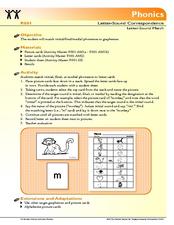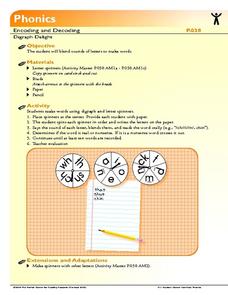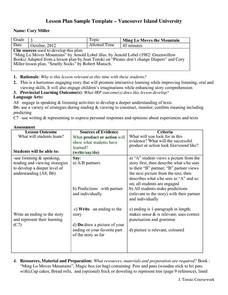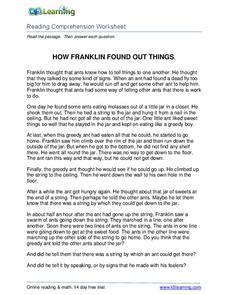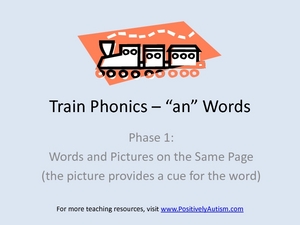K12 Reader
An Independent Nation
If your kids are curious about the American Revolution, help them understand more about its background with a reading passage and comprehension questions. Kids use context clues to answer each question, some of which require more...
K12 Reader
Endangered Species
Your learners have likely heard about animals going extinct. By reading this passage, they can find out some reasons why this happens and how to protect endangered species. After reading, individuals respond to five related questions.
K12 Reader
Magnetic Attraction
Teach your class about magnets and electromagnets with a reading passage. After reading the passage, learners respond to five related questions.
K12 Reader
Responsibilities of Citizenship
Your pupils are all citizens of your classroom. Provide some more instruction on how people can be citizens with the reading passage included here. After reading, learners answer the five related questions.
K12 Reader
Anatomy of a Circle
Make sure your learners are well-versed in circles with a reading passage. Pupils will pick up some important circle-related terms as they read and respond to the five included questions.
K12 Reader
Eastern Woodland Natives
Supplement your social studies instruction with a reading passage about the Eastern Woodlands. After reading the passage, learners respond to five related questions.
K12 Reader
Measuring Temperature
Fahrenheit? Celsius? What's the difference, and where did these two temperature scales originate? Your pupils will learn all about these topics by reading the passage included here. After reading, individuals respond to five questions...
K12 Reader
Taking Care of Earth
Provide a brief introduction to ecology and conservation with a reading passage. Learners can read the text, answer the five related questions that are included on the page, and discuss the reading.
Florida Center for Reading Research
Phonological Awareness: Phoneme Matching, Pack-a-Backpack
Scholars sort words based on their initial phoneme or sound. Learners are given two backpacks, each with a picture card; they search and match picture cards with the same initial sound as the ones on each backpack.
Florida Center for Reading Research
Phonics: Letter-Sound Correspondence, Letter Sound Match
Scholars match initial, medial, and final phonemes to individual graphemes. They pick a card, say its name, then find the letter that makes that sound. If the card is a monkey, the learner finds the letter m, matching the grapheme to the...
Florida Center for Reading Research
Phonics: Encoding and Decoding, Digraph Delight
There are three spinners to use in this phonic activity. Spinner one contains digraphs, spinner two contains vowels, and spinner three contains consonants. Learners spin each spinner, write down the letters they get, blend them to make a...
Vancouver Island University
Ming Lo Moves the Mountain
A good story is a great way to support skills that are necessary for encouraging strong reading skills. Here is a class I do, You do, We do style lesson that stars the tale, Ming Lo Moves the Mountain. Included are two fun pre-reading...
K12 Reader
Find the Meaning: JFK's Inaugural Speech
Analyze a seminal speech from the 20th century with an activity focused on President John F. Kennedy's inaugural address. After reading an excerpt from the address, pupils use a worksheet to practice their reading...
K5 Learning
The Blind Men and the Elephant
Sometimes it's necessary to view the whole picture before making a judgment about a small part. Read a short story about five blind men who try to identify an elephant by feeling different parts and coming to their own conclusions....
K5 Learning
The Bomb
Second graders read a brief passage about King Charles XII of Sweden who lived over 200 years ago. Then, they respond to four short answer questions about what they read.
K5 Learning
How Franklin Found Out Things
Franklin learns about the world by making observations, and so do we! A short reading assignment prompts fourth graders to answer comprehension questions about a curious boy and what he notices.
Curated OER
Train Phonics - /an/ Words
Follow the phonics train and get your special needs class on the reading track. To promote the /an/ sound and phonemic awareness, each page contains an image of a train, and each car contains an item. The word representing that item...
Curated OER
Fill-In l Remembering Dick Clark
Your scholars may have an idea of who Dick Clark is, but do they understand the role he has played in American history for over 50 years? Give learners some practice with media literacy as they read an article about Clark's life and fill...
Curated OER
Taken by Storm
Extreme weather can be frightning and as young readers find out, deadly. They read the New York Times artcle Taken by Storm and then answer eight comprehension questions. Note: Learners can post their thoughts about the article on...
Curated OER
Beginning Short Stories - "What Do We Have to Eat?"
After reading two short stories, learners identify vocabulary associated with food and eating. This activity with 5 questions could be used as a reading comprehension and vocabulary practice for younger students or an ESL worksheet for...
K12 Reader
The Big Pig
Pigs are often big, but what else can your class find out about this particular pig? They'll learn a few things about it by reading the poem full of -ig words, and then answering the three reading comprehension questions.
K12 Reader
The Bug on the Rug
Where did that bug go? Kids can find out where it is by reading this short poem that features -ug words and responding to the three included reading comprehension questions.
K12 Reader
Where On Earth Are You?
What do we use to determine the exact locations on the earth? Your kids can learn all about compass roses and latitude and longitude. Test understanding with the five reading comprehension questions included on the page.
Florida Center for Reading Research
Phonological Awareness: Phoneme Segmenting, Phoneme Closed Sort
Build phonological awareness with an activity that challenges learners to sort picture cards based on the number of phonemes each has.









